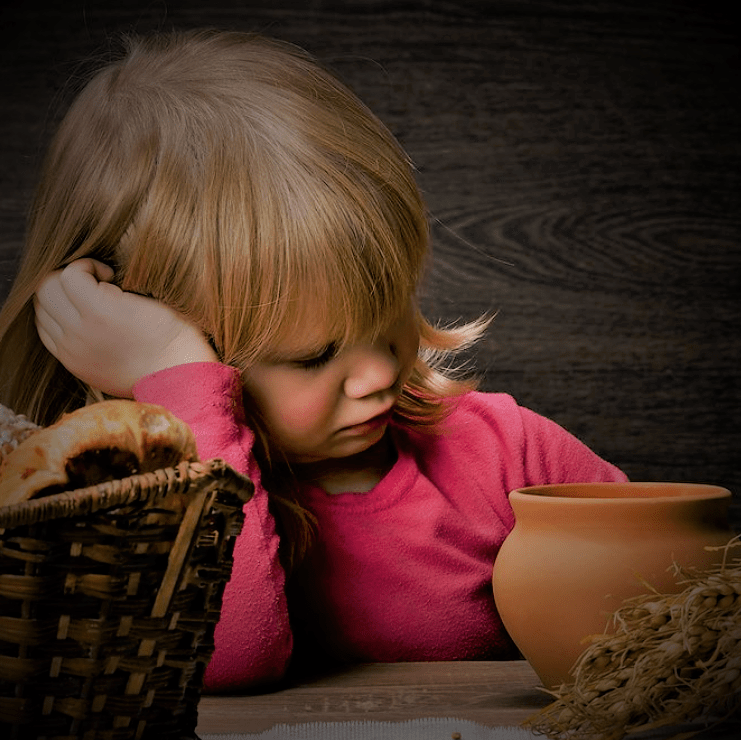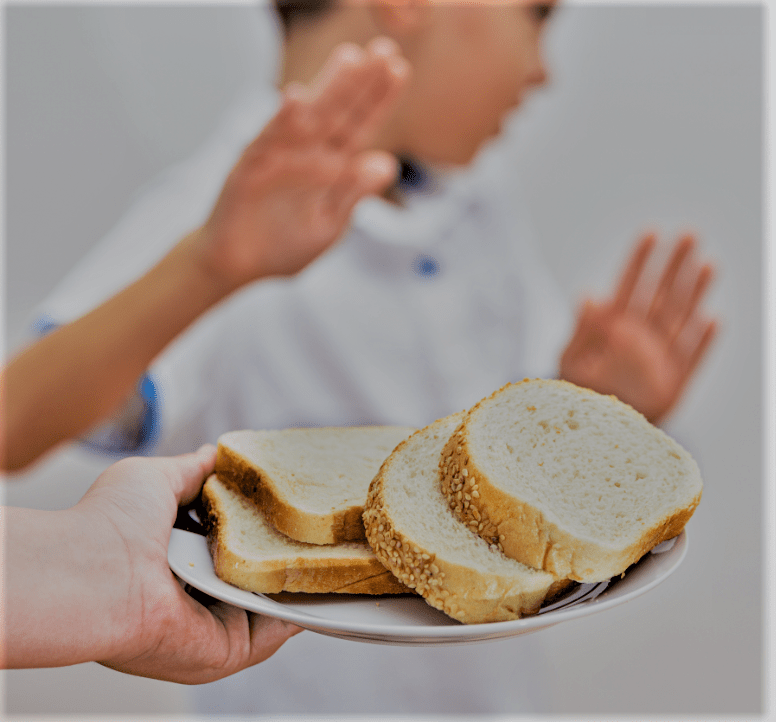Gluten intolerance symptoms in children and Gluten intolerance is the most common chronic intestinal disease in Spain and other places, probably because gluten is one of the most consumed proteins in our country. This means that all those babies and children who suffer from this intolerance must completely eliminate gluten from their lives. However, the first phase is to get a correct diagnosis, something that is not always easily achieved since the symptoms of gluten intolerance are similar to those of other digestive diseases.

Gluten intolerance is a much more common pathology in children affected by Down syndrome. You have to be especially attentive to your symptoms.
The symptoms of gluten intolerance are extra digestive and digestive, vary depending on age and, in addition, are not the same in all children. It is important to know them to try to make the diagnosis as early as possible. Therefore, we want to let you know a series of symptoms that can help you know if your child is gluten intolerant when you have certain doubts.
Symptoms of gluten intolerance in infants: Gluten intolerance symptoms in children
Celiac disease is an immune system disorder caused by an intolerance to gluten. It is also known as celiac sprue, gluten-sensitive enteropathy and non-tropical sprue.
Celiac disease is an immune system disorder caused by an intolerance to gluten. It is also known as celiac sprue, gluten-sensitive enteropathy and non-tropical sprue.
Gluten is a protein present in some cereals such as wheat, rye, barley and other derived cereals.
When a child is celiac, gluten damages the
villi of his small intestine, known as villi, whose function is to absorb nutrients from food. Therefore, the child does not absorb nutrients well and may suffer from malnutrition and other health symptoms.
Gluten intolerance can begin to manifest as early as 6 months, when gluten is introduced into the diet of babies. However, symptoms at first can be mild and occasional, so it is not usually diagnosed until about 2 years. In addition, these symptoms are often confused with
other digestive problems and disorders, so it can be difficult to know if the child has gluten intolerance or not.
The most frequent symptoms related to this disease are:
– Chronic or intermittent diarrhea
-Constipation
– Lack of appetite
-Nausea
-Vomiting
– Abdominal pain
-Flatulence
– Abdominal distension (very bulging gut and thin legs and arms)
– Smelly and pale stools
In addition, they may be accompanied by other extraintestinal symptoms such as apathy, introversion, decay, sadness, malnutrition, irritability, retardation in growth or weight loss, hypotrophy or muscle weakness, oral thrush, iron deficiency anemia, muscle cramps, bone and joint pain, tingling and numbness sensation of the legs, defects in tooth enamel, painful herpetiform rash in the form of itchy vesicular lesions and They are located symmetrically on the head, elbows, knees and thighs.
let’s now take a look of each symptoms.:
Symptoms related to digestion
Perhaps the most significant signs that can indicate that a child is gluten intolerant are those that have to do with the digestive system. Specifically, we are referring to some like these:
- That has, in a habitual way, swelling in the belly.
- You usually suffer from nausea that ends in vomiting.
- It is important to look at your stool. In addition to being smelly, they are also whitish.
- The child may suffer from both constipation and frequent diarrhea.
- The child may also complain that he has a lot of gas.
- At other times, you report that you often have tummy pain.
- There may also be a lack of appetite.
Perhaps the most significant signs that can indicate that a child is gluten intolerant are those that have to do with the digestive system. Specifically, we are referring to some like these:
That has, in a habitual way, swelling in the belly.
You usually suffer from nausea that ends in vomiting.
It is important to look at your stool. In addition to being smelly, they are also whitish.
The child may suffer from both constipation and frequent diarrhea.
The child may also complain that he has a lot of gas.
At other times, you report that you often have tummy pain.
There may also be a lack of appetite.
Signs at the level of growth
Other symptoms that warn that the child may be gluten intolerant are developmental delay, a shorter height than children of the same age and even a lower weight. Progressive muscle atrophy may occur in children under two years of age and, from the age of two, may have delayed puberty.

Risk groups for Gluten intolerance symptoms in children
Although any child can suffer from this intolerance, there are risk groups, such as:
- First-degree relatives.
- Children with type 1 diabetes.
- Affected with Down syndrome, according to a study published in 2016.
The disease affects white people markedly. It is also more common in women than in men, and is hereditary.
Diagnosis and treatment of gluten intolerance
As not all babies experience the same symptoms or at the same intensity, and many can be easily confused with other disorders, it is necessary to do an intestinal biopsy if it is suspected that the child may be celiac to confirm the intolerance.
If the result is positive, the only possible treatment is to completely eliminate gluten from the baby’s diet since gluten intolerance implies that the intestine cannot absorb this protein well, causing all the problems described above, especially nutrition.
Therefore, the baby, as he grows and incorporates foods into his diet, should totally avoid all those that contain gluten (wheat, rye, barley, oats or triticale) or starches.
In addition, you should be careful with processed or semi-processed foods as they may have gluten in their composition. Specifically, some sausages, processed cheeses with flavors, canned meats, canned fish with sauces, sweets and jelly beans, roasted nuts with salt, ice cream, etc.
You have to read the label of these foods well and check that the international symbol of guarantee, that is, the spike crossed out within a circle and the mark controlled by the Federation of Celiac Associations of Spain (FACE) since many products, although they put that they do not carry gluten, only means that the foods have been treated so that they have a lower content of this protein, But they are still not suitable for celiacs.
However, although it seems that there are many foods that should be avoided, there are also many that you can eat without problems, such as all fruits, vegetables, fish, seafood, meats, legumes, milk and dairy products, eggs, rice, corn, oils, fried or natural fruits … Of course, you have to be careful to consume them without sauces or with sauces that you know do not contain gluten in their composition.

Tips if your child is celiac
On the other hand, before being celiac was an odyssey since it was difficult to find gluten-free products in the supermarket (and they were much more expensive), go out to eat at a restaurant or stay in the school dining room. But in recent years things have changed a lot and has been promoted, from all areas, celiac care, so currently all supermarkets have a large number of gluten-free products at moderate prices, the menu of all restaurants includes which products carry gluten and which do not,
as well as a variety of foods for gluten intolerant (even fast food chains have hamburgers or pizzas for celiacs), and in all school canteens there is a special menu for children with food allergies.
Therefore, although at first it can be a bit hard to know that our child is celiac, the truth is that he can lead a totally normal life and enjoy like the rest of the children, you just have to be careful with what you eat. And, if you are a girl, you can have a pregnancy without problems when you are older.
Gluten intolerance in children, important early diagnosis
Gluten intolerance is 5 times higher in children than in adults. Currently, it is not possible to prevent this disease and the only treatment is to eliminate gluten from the diet. Therefore, if your child suffers from several of these symptoms, go to the doctor to be diagnosed and, later, a dietitian-nutritionist prescribes a gluten-free diet.
I hope this post clarifies and has helped you about this Gluten intolerance symptoms in children. Gain a comprehensive understanding of celiac disease symptoms in children and its long-term implications. Find support and expert advice here.Gluten-free baking without xanthan gum
If you liked the post aboutGluten intolerance symptoms in children you can share it on your favorite social networks (Twitter, Facebook, etc.…), ← you have different icons to click. Every day there will be new recipes and tricks for you, Follow us on Facebook @buzzrecipes12Share

